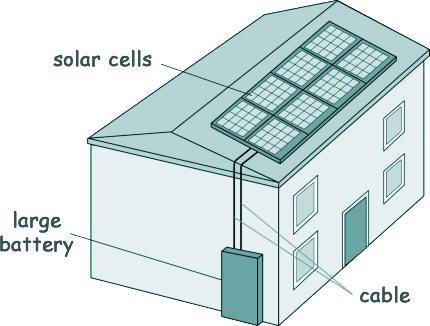GCSE Questions: Energy Sources
Q27.
(a) During one year, 1.25 × 1018 J of energy was transferred from the National Grid.
Given that the number of seconds in 1 year = 3.16 × 107 calculate the mean power transfer from the National Grid.
Give your answer to 3 significant figures.
Power = energy/time 
1.25 × 1018 J/3.16 × 107 
Power = 3.96 x 1010 J/s
P = 3.96 x 1010  W
W 
P = 39.6 GW
[4 marks]
(b) The diagram shows a house with a solar power system.
The solar cells generate electricity.
When the electricity generated by the solar cells is not needed, the energy is stored in a large battery.

(i) The charge flow through the cable between the solar cells and the battery in 24 hours box was 27 000 coulombs. Calculate the mean current in the cable.
t = 24 h = 24 x 602 s 
I = Q/t 
I = 27,000/(24 x 602) 
I = 3.125 x 10-4 A 
I = 3.1 x 10-4 A
[4 marks]
(ii) At one time, the total power input to the solar cells was 7.8 kW.
The efficiency of the solar cells was 15%
Calculate the useful power output of the solar cells.
Useful power output = 15% of total power input
Useful power output = 0.15 x total power input 
Useful power output = 0.15 x 7.8 kW 
Useful power output = 1.17 kW 
[3 marks]
(c) It is unlikely that all of the electricity that the UK needs can be generated by solar power systems. Explain why.
A really large area of land would need to be covered with solar cells 
due to (any one of the following reasons): 
the low useful power output/efficiency of the solar cells
number of hours of daylight in UK is too low
low solar intensity (in UK)
material for construction of solar cells and/or lithium batteries is in limited supply
[2 marks]
(Total 13 marks)







